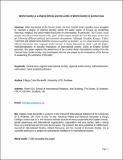Files in this item
World society as a shared ethnos and the limits of world society in Central Asia
Item metadata
| dc.contributor.author | Costa Buranelli, Filippo | |
| dc.date.accessioned | 2018-06-08T23:31:42Z | |
| dc.date.available | 2018-06-08T23:31:42Z | |
| dc.date.issued | 2018-01 | |
| dc.identifier | 246705915 | |
| dc.identifier | 7bfe9a28-c3ac-422e-952a-0a7d50d7c959 | |
| dc.identifier | 85020439018 | |
| dc.identifier | 000427075400005 | |
| dc.identifier.citation | Costa Buranelli , F 2018 , ' World society as a shared ethnos and the limits of world society in Central Asia ' , International Politics , vol. 55 , no. 1 , pp. 57-72 . https://doi.org/10.1057/s41311-017-0064-6 | en |
| dc.identifier.issn | 1384-5748 | |
| dc.identifier.other | ORCID: /0000-0002-2447-7618/work/60196659 | |
| dc.identifier.uri | https://hdl.handle.net/10023/13863 | |
| dc.description.abstract | After the demise of the Soviet Union, the five Central Asian republics have struggled to maintain a degree of regional identity within the wider region of Eurasia by combining historical, religious and value-related discourses of commonality. In particular, ‘the Central Asian people’ has always been hailed as the ‘glue’ of this region, despite the fact that states in this area are following different political and economic orientations. Although ‘Kazakhs, Kyrgyz, Tajiks, Turkmens and Uzbeks have lived for centuries together as brothers’, as it is often heard in regional official statements, this ‘regional world society’ is being fractured by what I call the hyper-institutionalisation of pluralist institutions of international society. Using an English School approach, this paper explores the detachment of the Central Asian international society from the Central Asian world society, and investigates into the role played by the institutions of the former in weakening the substance of the latter. | |
| dc.format.extent | 16 | |
| dc.format.extent | 469836 | |
| dc.language.iso | eng | |
| dc.relation.ispartof | International Politics | en |
| dc.subject | Central Asia | en |
| dc.subject | Regional international society | en |
| dc.subject | Regional world society | en |
| dc.subject | Authoritarianism | en |
| dc.subject | Nationalism | en |
| dc.subject | Hyper-institutionalization | en |
| dc.subject | JZ International relations | en |
| dc.subject | H Social Sciences | en |
| dc.subject | T-NDAS | en |
| dc.subject | BDC | en |
| dc.subject.lcc | JZ | en |
| dc.subject.lcc | H | en |
| dc.title | World society as a shared ethnos and the limits of world society in Central Asia | en |
| dc.type | Journal article | en |
| dc.contributor.institution | University of St Andrews. School of International Relations | en |
| dc.contributor.institution | University of St Andrews. Centre for Global Law and Governance | en |
| dc.identifier.doi | https://doi.org/10.1057/s41311-017-0064-6 | |
| dc.description.status | Peer reviewed | en |
| dc.date.embargoedUntil | 2018-06-08 |
This item appears in the following Collection(s)
Items in the St Andrews Research Repository are protected by copyright, with all rights reserved, unless otherwise indicated.

